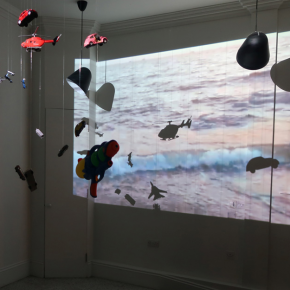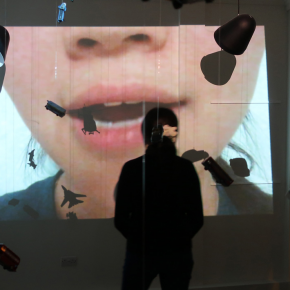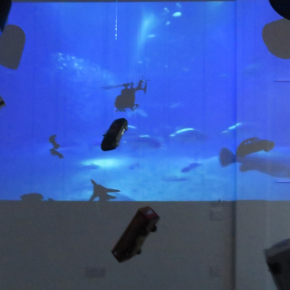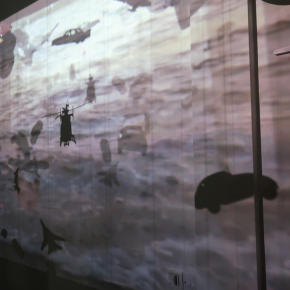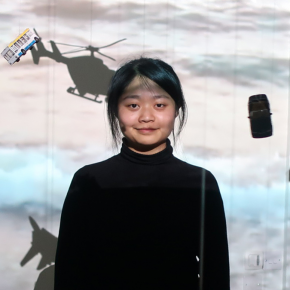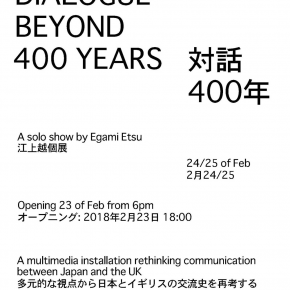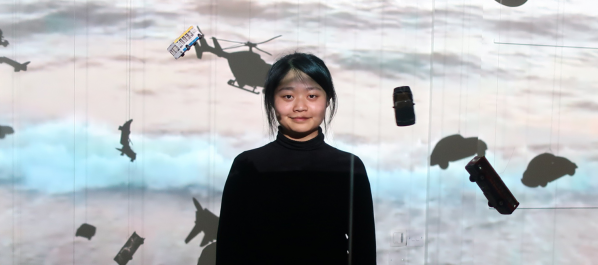
By Shigeo Chiba (Japanese Art Critics)
To be accurate, what Etsu Egami is trying in her work of "words (language)" is not a "misunderstanding" but a problem of "mis-hearing". Of course, "mis-hearing" can be the source of "misunderstanding", so it can be said that it doesn't matter if you expand it to "misunderstanding" in general, but then it seems that the story will be slightly misguided. "Misunderstanding", for example, could be serious understood as a prominent drama work "Le Malentendu" by Albert Camus. But it is common to add coloring to a conversation in everyday life, using homonyms sometimes with puns. For example, if you pronounce the word "misunderstanding" in Japanese only by sound,"Five Levels", "Go Session", "Gokai (Roswell)," "Five Commandments" can be the same sound either.
It should be noted that Etsu Egami herself uses the word "mis-hearing" rather than "mis-understanding" or "mis-apprehension". In other words, she has a theme of "mistakes" at the level of sense (hearing at now). People's sense is usually said to be "five senses". However, it is obvious that there are at least two other things, "body sensation" which is more extensive than "tactile" and a feeling arising from imagination in a broad sense, so to speak and "imagination feeling" (such as premonition or delusion) I think that should be added I think. Also of course, here also, "sensation" is not a physical stimulation up to the stage where it reaches the brain, but it It refers to becomes a (total) judgment by the brain and it becomes behavior, that is, "recognition" what it is.
And, for example, do not forget the fact that other feelings are not asleep while one hears. Even if I close my eyes and listen to music, other senses except vision are also working. So hearing is working with all senses (except vision). Even when drawing a picture, vision works with all other senses. Human "sense" is always more or less comprehensive. Apparently, the human brain seems to be made like that. Besides, do not forget that Etsu Egami is a painter first, or is also a painter.
In other words, Etsu Egami's "Mis-hearing of words" should be linked with at least vision. There is a reason why her "mis-hearing games" work is an exhibit , mostly or often image wise, or with such installations. It also sometimes emphasizes "Mis-hearing" that occurs in the sense of hearing, but that is not all. "Mistake = malfunction" that occurs in one sense exerts its effect on the whole human sense.
The inspirations for Etsu Egami's "mis-heariing game" works comes from her personal experiences when she was studying in Beijing. Japan and China share the same kanji, but at the present in the 21st century, even if the same kanji or the same word is pronounced as "sound", there are circumstances in which both sides do not have the same meaning. She was inspired by the misunderstandings and discrepancies of that. But only that, it is only a misunderstanding of the meaning of words and a matter of discrepancies. Hieroglyphics called kanji form a lot of different readings historically and locally for each character (kanji), and it is of course that once you leave the mainland of China its reading will be changed.
The problem of "misunderstanding" that came from there will not be solved in the future, it will continue to produce tragicomical stories. Conversely, efforts to solve or mitigate will also continue. However, Esperanto and English cannot conquer the world, and I want to say sorry to such a world. If land, water, culture and air are different, naturally humans and their languages are different. There is a reason ,necessity and nature in that, diversity is a good thing.
As an artist, she immediately noticed that. And from the level of "the misunderstanding and discrepancy of the meaning of the words", She is trying to extend the problem to a bigger, more fundamental direction.
One of them is the direction of bringing out differences between countries and regions, that is, differences in civilization and culture. It can be said that it is a direction to positively recognize the diversity that "mis-hearing" occurs. Since "mis-hearing" is inevitable, it is a way of thinking that it is positive.
By the way, her painting work depicting "human face" can be said to be an attempt to bring that idea visually. People 's face are changing constantly and constantly. That is what is said to be an "expression". The immigration officer has to compare the face photograph on a passport with the face of the person in front of the his eyes, even with a machine that proposes to reflect reality as it is like a photograph. It is because they can't catch the delicate changing of facial expression of a person. Photographs can only catch a little moment, but paintings can describe the diversity of human facial expressions. It may seem that Etsu Egami's painting exaggerates features and expressions, but it is not. She was trying to draw the face of a person who can not be caught in one shot as comprehensively as possible. It is a work drawn by incorporating "mis-seeing" corresponding to "mis-hearing" as a fold. So basically it stands in the same way as a "mis-hearing game", but it is a painting work.
Another direction that I think might be possible , would be the direction to try the same thing with a work that combines "auditory" with "visual" (linked, juxtaposed, dressed) . It may be a dream, but I am thinking about that.
What the sea plunges, things that connectBy Prof. Dr. Shigekazu Kondo
Emeritus Professor University of Tokyo
Chiba City Arts and Culture New Award Selection Committee Chairperson
Professor of The Open University of Japan
In the middle of the Eurasian continent, both cars and trains run on the right side, but Japan and the UK , which are floating across the sea over the east and west side of the continent ,are driving on the left side. Traffic on the left side in Japan was due to upgrade the modern transportation system following to the UK. It seems that the sea, which separated the transportation system between the UK and the continent , made them different, but it was also the sea that conveyed the British transportation system to Japan.
In 1600, the British William Adams (1564-1620) had gotten on to the Dutch merchant ship Releafde (De Liefde) as a navigator, but as the ship was drifting in Japan, he became the first British who landed in Japan . Adams was heavily used in the Tokugawa family who will dominate Japan for just over 260 years from that year. He spent the rest of his life in Japan, where he was involved in opening a British trading house in Japan, and died in Japan.
The TV drama "Shōgun" produced by the American / NBC in the 1980s used Adams as a model. For the hero who could not speak Japanese at first, the mentality of Japan were beyond his understanding at all, but gradually he became accustomed to the Japanese life and learned to understand the mindset of Japan. This drama is made to let the English speaking audience pursue the process.
In Etsu Egami's work, there is some her work that reflects the sea and questions the possibility of communication. It is said that the mentioned sea is Chiba's sea which is the hometown of Egami. Egami recently won the Chiba City Arts and Culture new artist Prize from Japan. The Mayor of Chiba city, is pleased about the existence of Etsu Egami's work which that raised the sea of Chiba. He emphasizes that Chiba is surrounded by the seaside in the south ,the east and the west. Indeed there was a time when maritime traffic played a major role for connecting this area with other areas.
One of Etsu Egami's themes seems to be "misunderstanding". It is inevitable to have false recognition at the beginning of communication. Rather, noticing false recognition as misunderstanding may be the only way to get the right recognition. Etsu Egami's "misunderstanding" is such a misunderstanding, isn't it? This may be also a misunderstanding of Etsu Egami, but I'd like to start seeing Etsu Egami's works from that kind of perception.
Dialogue beyond 400 yearsBy Etsu Egami
In 1587 the British seized the Spain galleon ship off Baja California and added the two Japanese who were on board to his ship. These two people became first Japanese who visited the UK. If this story is the start of exchange between Japan and the UK, communication from the beginning it can be said that accompanied by misunderstandings and accidents. Also in 1600, the British William Adams (1564-1620) was a navigator on the Dutch merchant ship Releafde (De Liefde), but as the ship was drifting in Japan, he became the first UK person landed in Japan. He was trated as important by the Tokugawa Bakufu, he spent his late life in Japan and he also involved in opening up a British Trading Post office in Japan.
About 400 years since the communication between Japan and the UK started. After 400 years of long history, looking back, It have overcome many hardships and have developed. Among them, there are facts that resulted and many initial applications is different, and many of them are thought to be due to misunderstanding of communication, misunderstanding and mishearing. Misunderstanding often has negative consequences, but sometimes it leads to evolution. This is also the focus of my creation.
Japan imports warships, steam engines, tracks, etc from the UK, exports high performance electric products, automobiles, technology etc. While Western art influences Japan, Ukiyo-e and popular Japanese Kawaii culture are also popular in the UK. Beginning with gun diplomacy, progress towards economic and cultural exchange. These results of turning points and dislocation seems deeply meaningful.
In my work , Mis-hearing game is the starting point ,to verify the obstacles and the possibility of communication. Based on the historical materials exchanged between Japan and the UK and the images of the sea , we can experience the changing and overblown mistakes in the nautical era in a relaxed and humorous atmosphere. It prompted he other side of human communication behind changes in the times . "Mis-hearing" feels very casual occasionally and personal, but will it be a human genetic heritage? My current work is to try to expand the “Mis-hearing" and extend it to exchanges between countries and regions and extend the collision between ethnic groups and cultures.
Julia von Meiss (Curator)
To explain Egami Etsus installation in the context of Playground it might be good to write a bit about our concept. Unlike other galleries, Playground is a hybrid between exhibition and studio space, purposefully leaving it’s definition – and use - as open as possible. Our main aim is to provide a physical platform for people with talent and initiative, regardless of discipline. The space is to be used in the most suitable way for their "art".
So our role as curator is less making decisions about set up and outcome of the installation but more that of a mentor; giving advice, drafting written concepts, providing visual communication and giving realistic deadlines.
Making culture, language and barriers of communication as a central subject of most of her work, the development of her exhibition idea within our very open concept was an important part of the outcome in my opinion. For us, it was really interesting to see how Egami Etsu developed her idea and the process of adapting it to a relatively restrictive room, both in shape and size.
Overcoming her initial idea of a classic “gallery” and realising she has got a space where she is completely free to play in and create her own exhibition was a great step.
And finally, once set up, having lots of people from different cultures, interests and professions all interacting with each other and reflecting on the installation was great to witness. Needless to say that Egami Etsus artwork seems to be visually very appealing independent of cultural aesthetics.
About the exhibition
Dialogue beyond 400 years: A Solo Show by Etsu Egami
Curator: Antonia Huber, Julia von Meiss
Venue: Playground London Curated place
Sponsor: Japan SINBY
Courtesy of the artist.


